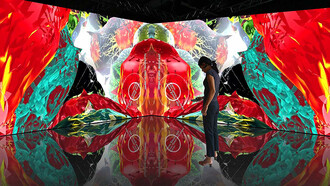Amongst the swathes of essays and learned tomes on Alberto Giacometti (1901-1966), there is much waxing lyrical on this sculptor who seems, by many, to be rated as if though he had single-handedly mustered the combined forces of Prometheus and Athena. I am therefore dissuaded from the exercise in futility that would be to continue in such a vein as eminent scholars such as Yves Bonnefoy or Véronique Wiesinger. I am drawn instead to say something on the physical obsession for making, for repetition and for the human figure that characterizes the work of Giacometti as seen within the splendid confines of London’s Tate Modern (until the 10th of September).
Speaking as I do, with some considerable hands-on experience of wrestling with clay, plaster and steel to try to (re) create some semblance of the human figure, when seeing Giacometti’s work again after a lengthy gap, I find myself experiencing the oddly contradictory sentiments of both empathy and pity for the artist. If this sounds condescending then it certainly isn’t meant to be.
My late and very dear friend Leslie Thornton stated, (with his usual Yorkshire directness), that those artists who chose the vehicle of figurative sculpture to relay their practice were ‘making a rod for their own backs’. To understand this, one needs also to understand that the materials of figuration, as previously described, are as unforgiving to work with as they are unsympathetic to those who wish to ‘capture’ any fleeting moment or mood. The fact is that working with steel and clay and plaster and bronze or cast iron to create figurative sculpture is a difficult, dirty and frequently soul-destroying affair. Ask anyone who has had the need to take a corrective hammer to their skeletal steel armature to get it back inside the flesh of the clay, or the bronze carver, who realizes too late that the angle grinder is the only tool for post-foundry surgical removal of what would have been a mere cosmetic, momentary removal by spatula in the clay or wax stage.
Taken sympathetically within the refined and atmospherically controlled environment of Tate, the mantra of Giacometti’s figures can easily be received as contemplative, and reiterative, as if of a reverie. The disquieting reality for me as a maker, is that Giacometti was almost certainly obsessive, possibly autistic and arguably masochistic. Picasso (amongst others), criticized his repetitious approach and outputs and his seemingly relentless quest for the fugitive through the most fugitive (most fixed) of means.
Whilst Giacometti embraced existentialism and mixed authentically with the likes of Sartre and Beckett, was friendly with Picasso, and was taught by Bourdelle, when one looks at this work we might divine some of the same dark and introspective traits of some of his fellow Italians: Bernini, Caravaggio, Modigliani, Parmiggiani, Pistoletto and more particularly Morandi. I could be accused of stretching a point here of course, but if anyone could really explain away the mortal fixations of Morandi and Giacometti as not being a product of language formed by the likes of Dante and Petrarch, then I am open to offers.
I have digressed much here, I have done this to prove two points; firstly to skillfully evade the well-worn ruts of critics, but secondly, and more importantly, to give redress to the feeling I often have when I hear critics and curators talking without much understanding of the ins and outs and sheer drudgery of making. Without this insight, it is too easy to see sculpture as the embodiment of spontaneously conjured conceptual/philosophical matter(s) rather than the product of a hard-won dialogue.
Making things that stand up, that aren’t wonky or unintentionally unbalanced, that capture the feeling of being a figure through intransigent materials, is usually incredibly taxing. Without wishing to conclude unsympathetically, Giacometti, working as he did with the method of someone playing the odds and laws of probability, managed to capture more than most within one lifetime, but as we can see from this show (which is exquisitely curated), not all of the time.















